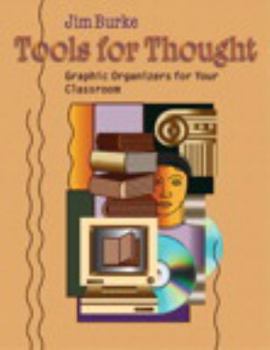Tools for Thought: Graphic Organizers for Your Classroom
Dozens of graphic organizers and a hundred ways to use them Jim's prepared a workbook that's a real workhorse, providing tools to spark student thinking that are both intriguing and precise--and applicable to grades 6 to 12 in all subject areas. These tools range from annotations and literature circle notes to Venn diagrams and vocabulary squares. Each comes as a reproducible accompanied by:
Format:Paperback
Language:English
ISBN:0325004641
ISBN13:9780325004648
Release Date:August 2002
Publisher:Heinemann Educational Books
Length:208 Pages
Weight:1.15 lbs.
Dimensions:0.5" x 8.6" x 11.1"
Customer Reviews
4 ratings
Tools for thought
Published by Thriftbooks.com User , 16 years ago
If you are a new teacher or a veteran this book is a great resource to help with notes, graphic organizers and literature ideas. The templates are user friendly and explained very well. A must for the classroom!
The graphic organisers in the book will find more appropriate use in the language arts!
Published by Thriftbooks.com User , 17 years ago
Tools for Thought: Graphic Organisers for Your Classroom by Jim Burke Books on graphic organisers & visual tools have generally fascinated me for more than two decades, probably in the light of my own personal interests in visual thinking. Also, my strategy consultancy work with adults & teens in helping them to navigate reading materials is a contributing factor. I have already amassed a large collection of them in my personal library. Strategically & tactically, I am a avid practitioner of visual thinking. When I read, I always annotate in the margins. I also strenuously use the MindManager Pro & SmartDraw Pro to support all my reading - & thinking - pursuits. All the interesting ideas captured in my marginal annotations - & insights from my reflections & assimilations - are alway transformed into mind-maps & /or mind-scapes. This book has recently entered my library. It has been written by a English Language teacher. Therefore, I noted that the book has an obvious slant towards applications in language arts. There are twenty six tools listed in the table of contents & twenty four of them are illustrated graphically in the Toolbox: Visual Directory of the Tools. Each tool has its own description, notes & examples, assessment standards as well as application possiblities. From the teaching standpoint, the inclusion of thirty two reproducible tools for classroom use is certainly an added benefit for teachers. The 'Annotations' on page 1 is definitely not a graphic organiser. The author admitted that "it looks a little different from the other tools, yet it is no less a tool." The author's idea of incorporating such things as crayons, high-lighters, pencils, coloured pens, sticky notes & symbol codes is a refreshing change to conventional annotations. The author's introduction of 'Visual Explanations' on page 114 is another refreshing innovation. He has based it on the work of information scientist Edward Tuft. In some way, the many examples shown resemble the 'mindscapes' as formulated by Nancy Marguiles in 'Mapping InnerSpace'. Incidentally, mindmapping created by Tony Buzan is lumped together in this section. The graphic format of 'Vocabulary Squares' on page 124 is very useful & practical, but I believe using it in combination with an index card would be much more effective. Sentence constructions can be written on the flip side. I am intrigued by a number of 'discrepancies' I have found in this book: 1) On page xvii, under 'Making Effective & Efficient Notes', what follows is actually a full description of 'Cornell Notes'. I am surprised that the author did not mention this fact & also did not credit it to Professor Walter Pauk of Cornell University. 2) 'Cornell Notes' is mentioned in the 'Appendices' on page viii, but it is inserted before 'Q Notes' & after 'Pyramid Notes' on that page, thus upsetting the alphabetical order of all the other graphic organisers as listed. Likewise, a reproducible form
Wow!
Published by Thriftbooks.com User , 18 years ago
This is my FAVORITE teaching book. It has graphic organizers that are neither too simple nor too challenging for high school level students, and better yet, examples of how to use each. A must-have for all English teachers!
Excellent Tool for teachers!
Published by Thriftbooks.com User , 20 years ago
Jim Burke created (and compiled) a lot of useful graphic organizers in this book. Each organizer comes with the author's explanation and examples. The book is my most useful toolbook in my collection. It helps my teacher and student learning. Highly recommended!




